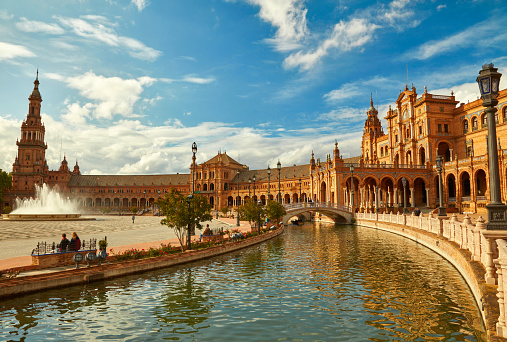
SEVILLE - A Travel Guide
 The city of Seville is like the headquarters for all things quintessentially AndalucÃaâ??after all, it is the regionâ??s capitol. Seville is spewing with AndalucÃan cultures and traditions, with architecture inspired by Gothic and Baroque styles. The narrow and winding medieval streets are lined with open-air shops and tapas bars, patio fountains filled with flowers, and the air is filled with the sweet scent of orange blossoms.
The city of Seville is like the headquarters for all things quintessentially AndalucÃaâ??after all, it is the regionâ??s capitol. Seville is spewing with AndalucÃan cultures and traditions, with architecture inspired by Gothic and Baroque styles. The narrow and winding medieval streets are lined with open-air shops and tapas bars, patio fountains filled with flowers, and the air is filled with the sweet scent of orange blossoms.
Seville is the original home of two AndalucÃan traditionsâ??bullfighting and flamencoâ??which also makes it one of the most exciting and entertaining cities to experience in our tours of Spain. To see a Sevillano decked out in traditional flamenco finery is quite a treat. And if youâ??re lucky enough to experience Sevilleâ??s Semana Santa (Holy Week) precession, then you have truly taken in the real Andalucian culture.
MUST SEE AND DO
Sightsâ??
Alcazar: Youâ??ll feel like youâ??ve gone to Heaven when you step inside this royal palace
Cathedral and Giralda: The worldâ??s largest cathedral; the Giralda sits right beside it
Parque de Maria Luisa: A peaceful park surrounded by Sevilleâ??s most beautiful architecture
Casa de Pilatos: Breathtaking palace and model of the Golden Age
Metropol Parasol: Often referred to as the modern-day Eiffel Tower
Museumsâ??
Museo de Bellas Artes: The art displayed here does justice to Sevilleâ??s role in the Siglo de Oro.
Palacio de Condensa de Lebrija: 16th-century mansion with a rich display of art and artisanry
El Pabellon de la Navegacion: Ultramodern navigation museum and exhibition space
Diningâ??
Enjoy some of the best traditional tapas at Enrique Becerra or Cerveceria Giralda, or a twist on original tapas at Eslava. For the true meat-eaters looking for adventure, go to Meson Serranitoâ??where they serve up award-winning bullâ??s tail. Visit Sevilleâ??s oldest bar/restaurant called El Rinconcillo, which has been around since 1670. After dinner, enjoy unique ice cream flavors at Heladeria La Fiorentina, or a pastry with Sevillian orange marmalade from Horno de San Buenaventura.
Night Lifeâ??
One simply cannot visit Seville without soaking in the beautifully ornate flamenco culture. The best â??tablaosâ?? to experience this passionate performance are Los Gallos and El Arenal. Head over to the Alameda for a great bar hopping scene. Take a late night cruise of the Guadalquivir River, where most boats tours include drinks! Family Friendlyâ?? Isla Magica: Great theme park with lots of rides and shows Cycoltour: Rent the â??cyclobusâ? with enough seats for the family and tour the parks Barrio de Santa Cruz: This Jewish Quarter has exciting maze-like streets The Plaza de Toros de la Maestranza: Take the kids to see a bullfightâ??itâ??s a blast
HISTORY
In 45 BC, Seville was given the status of Colony by Julius Caesar, and the city began to flourish. In the 7th century, Visigoths invaded and dominated Seville, and turned it into the most important cultural area in Spain. However in 712, Arabs overtook the city and transferred their center of power from Cordova to Seville. The city again flourished under their rule, until 1248 when Christians took over and forced Muslims out of the region. Churches were erected to replace mosques. Sevilleâ??s patron saint, Ferdinand III, died in 1252, giving his son authority, which he took to develop a more tolerant approach to Jewish, Arab, and Christian knowledge alike.
In 1492, Granada was overtaken and Seville became the headquarters of the Spanish Inquisition. When Christopher Columbus discovered America, Seville experienced its apogee, and the new American market quickly made Seville the wealthiest city in Spain and the most powerful in Europe. A plaque in 1649 brought decline to prosperity and population. It wasnâ??t until Queen Elisabethâ??s reign in the 19th century that Spain began to rebuild power. The Elisabeth bridge was erected and the wall around the city torn down, which gave birth to new roads. Today the Andalucian capital still flourishes and has even been host of the Universal Exposition.
GEOGRAPHY AND CLIMATE
Seville sits on the east bank of the Guadalquivir River. It is also a seaport, connected with the Atlantic Ocean by the river and a canal. As if the city couldnâ??t get any more perfect, Seville boasts almost ideal weather. Spring and autumn are mild, reaching a refreshing 68 F/20 C. Spring is the perfect time to go because the orange blossoms are in bloom, and the Semana Santa is in precession. Nonetheless, winter temperatures only reach about 40 F/5 C, and summer about 95 F/35 C, so there is really no wrong time to visit this amazing city.
